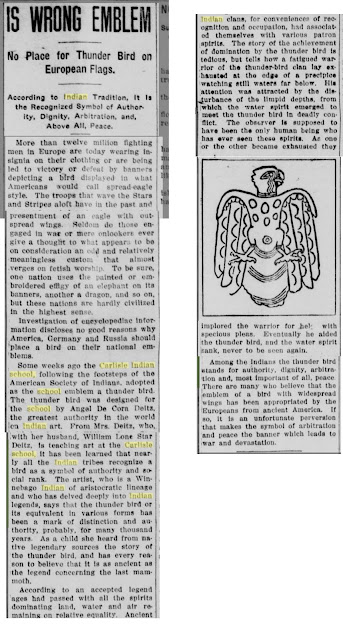In 1914, the Thunderbird (a Native American symbol and myth) was used as an emblem for the US military. Angel De Cora, a prominent indigenous artist, called it "an unfortunate perversion."
Some weeks ago the Carlisle Indian School, following the footsteps of the American Society of Indians, adopted as the school emblem a thunder bird. The thunder bird was designed for the school by Angel De Cora Deitz, the greatest authority in the world on Indian art. From Mrs. Deitz, who, with her husband, William Lone Star Deitz *, is teaching art at the Carlisle school, it has been learned that nearly all the Indian tribes recognize a bird as a symbol of authority and social rank. The artist, who is a Winnebago Indian of aristocratic lineage and who has delved deeply into Indian legends, says that the thunder bird or its equivalent in various forms has been a mark of distinction and authority, probably for many thousand years. As a child she heard from native legendary sources the story of the thunder bird, and has every reason to believe that it is as ancient as the legend concerning the last mammoth.
According to an accepted legend ages had passed with all the spirits dominating land, water and air remaining on relative equality. Ancient Indian clans, for conveniences of recognition and occupation, had associated themselves with various patron spirits. The story of the achievement of domination by the thunder bird is tedious, but tells how a fatigued warrior of the thunder-bird clan lay exhausted at the edge of a precipice watching still waters far below. His attention was attracted by the disturbance of the limpid depths, from which the water spirit emerged to meet the thunder bird is deadly conflict. They observer is supposed to have been the only human being who has ever seen these spirits. As one or the other became exhausted they implored the warrior for help with specious pleas. Eventually he aided the thunder bird, and the water spirit sank. Never to be seen again.
Among the Indians the thunder bird stands for authority, dignity, arbitration and, most important of all, peace. There are many who believe that the emblem of a bird with widespread wings has been appropriated by the Europeans from ancient America. If so, it is an unfortunate perversion that makes the symbol of arbitration and peace the banner which leads to war and devastation.
* William Lone Star Deitz was the German who took the identity of One Star, a real Sioux, and later coached for the Washington Redskins. Many people believe that he was, in fact, an American Indian and that the Washington team was named for him. Both are incorrect. I'll prove this at a later time.





